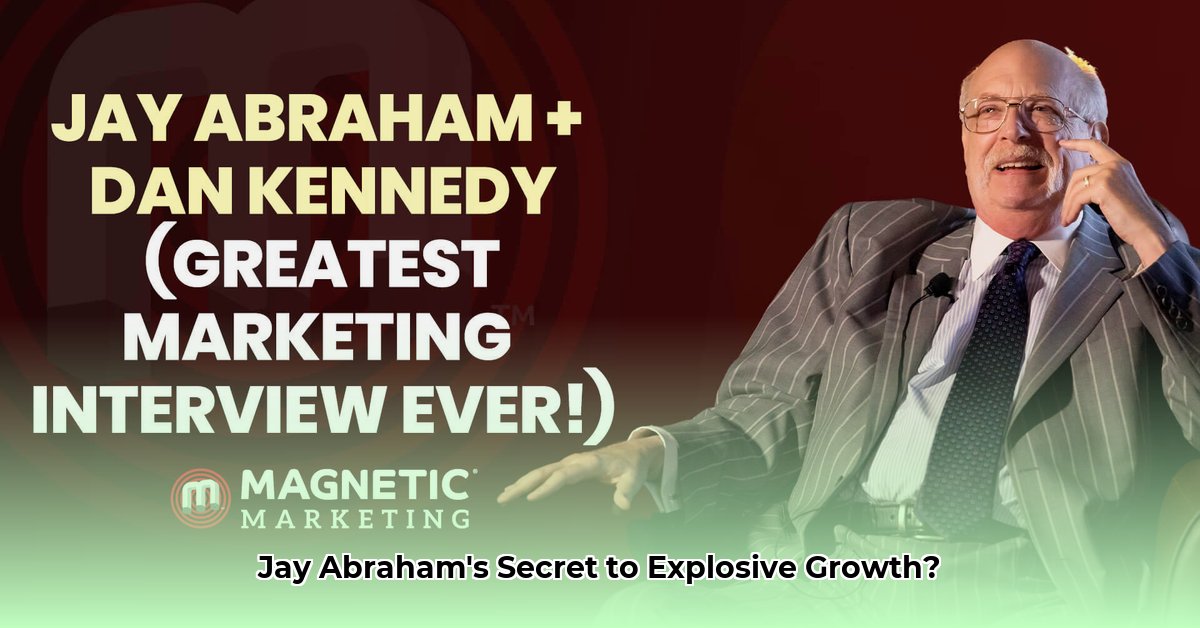
Want to unlock the secrets behind Jay Abraham's remarkable success? This isn't just about his impressive net worth; it's a practical guide revealing the actionable marketing strategies that fueled his empire. We'll dissect his winning approach, from mastering direct response marketing to cultivating enduring customer relationships. Prepare to supercharge your business with proven techniques and actionable steps designed for entrepreneurs of all sizes.
Mastering Direct Response Marketing: The Art of the Irresistible Offer
Jay Abraham's foundation lies in direct response marketing – the art of creating offers so compelling, they practically sell themselves. He didn't just broadcast messages; he orchestrated experiences designed to convert. How did he do it? Let's explore the key steps:
Step 1: Deep Customer Understanding: Before crafting any offer, intimately understand your ideal customer. What are their pain points? What problems keep them awake at night? The deeper your understanding, the more effective your solutions will be. Think of it as writing a love letter, not a sales pitch.
Step 2: The Irresistible Offer: Your offer isn't just about your product; it's about the transformation it provides. What unique value do you deliver? What problem do you solve elegantly? Consider adding bonuses, guarantees, or exclusive access to amplify its appeal. Think big, think value, think transformation.
Step 3: Compelling Messaging: Your marketing message must persuade, not just inform. Keep it concise, clear, and benefit-driven. Use strong action verbs and leverage storytelling to connect with your audience on an emotional level. Remember, words are your most powerful tools.
Step 4: Strategic Channel Selection: Don't waste resources on ineffective channels. Focus your energy where your ideal customer spends their time. Consider social media, email marketing, paid advertising, or direct mail. Know your audience's media consumption patterns.
Step 5: Data-Driven Optimization: Track your results meticulously. Monitor click-through rates, conversion rates, and ROI (Return on Investment). Use this data to refine your strategy continuously. What works? Double down. What doesn't? Ditch it and try something new. The data dictates the path to success. Isn't this a crucial element of understanding how a marketing legend built his wealth?
Building Unbreakable Customer Relationships: The Lifetime Value Advantage
While quick sales are tempting, Abraham understood that true wealth lies in long-term customer relationships. Retaining existing customers is far cheaper than constantly acquiring new ones. He focused on building loyalty and making his clients feel valued. Here's how:
Step 1: Exceptional Customer Service: Go above and beyond. Surprise and delight your customers. Respond promptly to inquiries, anticipate their needs, and proactively address issues. Happy customers become repeat customers and brand advocates.
Step 2: Community Building: Create a space where customers connect with each other and your brand—an online forum, Facebook group, or in-person events. This fosters a sense of belonging and makes customers feel valued.
Step 3: Reward Loyalty: Implement a loyalty program. Offer exclusive discounts, early access to new products, or special perks. Show appreciation for your most valuable asset—your loyal customers.
Step 4: Continuous Improvement: Actively solicit feedback through surveys, reviews, or direct communication. Use feedback to improve products, services, and overall customer experience. Show your customers that you care about their needs.
Adapting to Change: The Key to Enduring Success
Markets are dynamic. Abraham thrived by adapting to change, embracing innovation, and pivoting when necessary. His philosophy? Stay agile, learn from setbacks, and constantly evolve.
Step 1: Market Monitoring: Actively track market trends and industry news. Understand emerging technologies and competitor actions. Staying informed allows you to proactively adapt, rather than react to change. Anticipate shifts before they impact your business.
Step 2: Embrace Innovation: Don't cling to outdated methods. Experiment with new technologies and marketing strategies. What worked yesterday may not work today. Continuous learning and adaptation are vital.
Step 3: Calculated Experimentation: Don't fear venturing outside your comfort zone, but experiment strategically. Track your results and learn from both wins and losses. Data-driven decision-making guides your evolution.
Step 4: Learning from Failure: View failures as valuable learning experiences. Analyze what went wrong, adjust your approach, and try again. This iterative process is essential for growth and adaptability.
Measuring Your Success: Data-Driven Decisions, Real-World Results
Success wasn't accidental for Abraham; it was meticulously planned, measured, and refined based on data. He tracked key performance indicators (KPIs) and made adjustments accordingly. This allowed him to optimize campaigns and maximize ROI.
| Metric | Description | Importance |
|---|---|---|
| Customer Acquisition Cost (CAC) | The total cost of acquiring a new customer. | Crucial for profitability; helps determine how much you can afford to spend per customer. |
| Customer Lifetime Value (CLTV) | The total revenue a customer is expected to generate throughout their relationship. | Essential for sustainable growth; guides long-term investment decisions. |
| Conversion Rate | The percentage of prospects who convert into paying customers. | A direct indicator of marketing campaign effectiveness. |
| Return on Investment (ROI) | The profit generated from an investment. | Shows the profitability of various marketing strategies; guides resource allocation. |
Want to build a successful and profitable business? Study, implement, and adapt Abraham's strategies. Lasting success isn't luck; it's the result of intelligent, consistent, and adaptive marketing. It's about building a business that's not only profitable but also resilient and ready for the future.